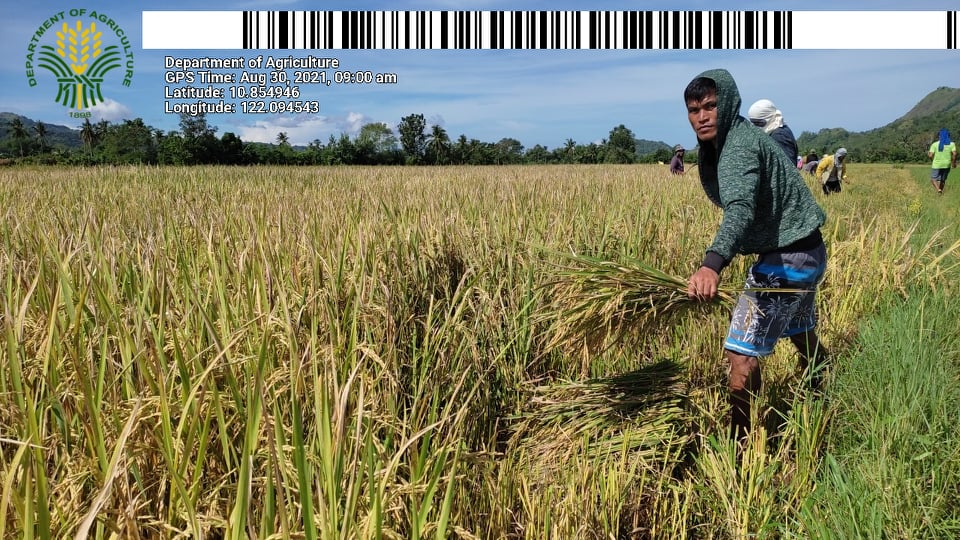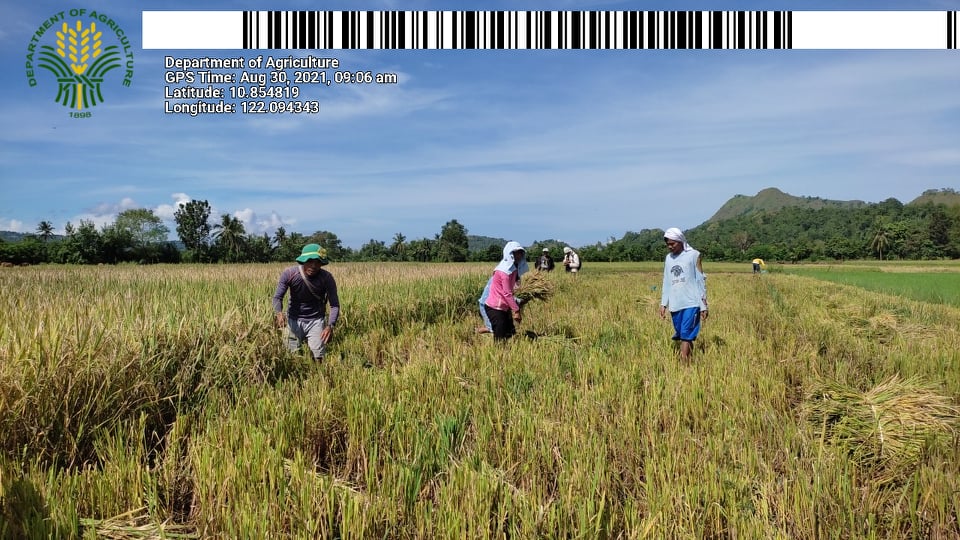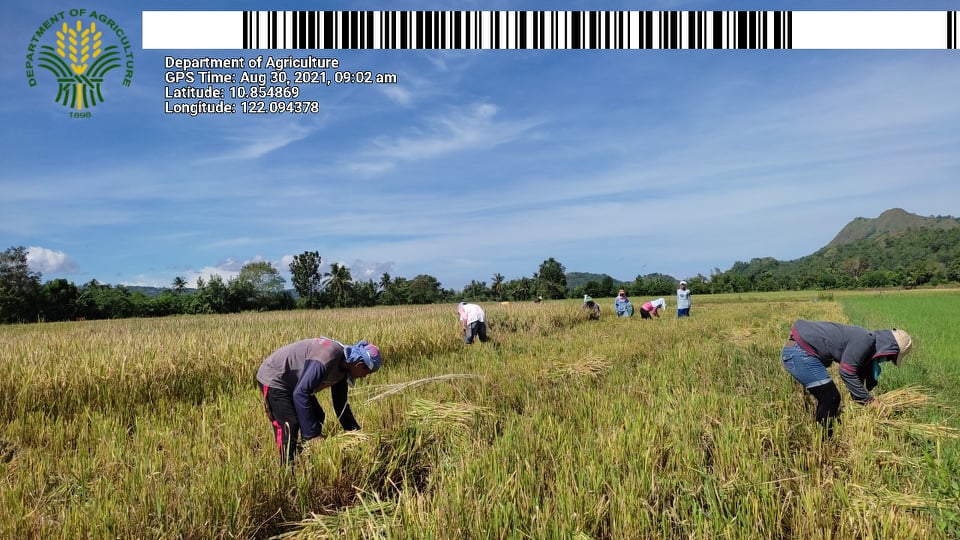About MAGVIBA rice farmers
In the hinterlands of San Remigio, Antique where development could hardly reach, a relatively small group of rice farmers sprung in Barangay Magdalena. Creating an inclusive group that would secure a hunger-free community pushed the locals to build an organization which was later on named as Magdalena Vilvar Baladjay Farmers’ Association (MAGVIBA).
In 2008, the local government unit through the Municipal Agriculturist’s Office encouraged the MAGVIBA farmers to register themselves as an association to the Department of Labor and Employment (DOLE).
They eventually became eligible as a beneficiary of the SAAD Program in 2021. Prior to the provision of agri-inputs, a series of social preparation activities and technical training on rice production were also done.
Rice production and management
Rice production is the main source of income in the area cultivated in two different ecosystems, the rainfed and irrigated which allow the farmers to be able to produce their crop twice a year. In rainfed, the bunded fields that are flooded with rainwater are ploughed by a buffalo to a depth of 70-100 millimeter, repeated 3-6 weeks later after which the fields are harrowed. For the irrigated land, the rice is grown in paddies with erected bunds created to keep water on the fields during tillage.
In harvesting, the technique remains manual since farmers have little to no access to any form of postharvest equipment. They manually cut the crops with their sickle and tied in sheaths, of which the farmers said that the whole process is time labor intensive.
However, their rice farms did not guarantee them good fortune. In each 0.4 to a hectare rice area, they could only harvest a maximum of 5-8 sacks, either kept for consumption and marketed in the lowland areas and in their neighborhood, giving them Php 1,500-2000.
Results in twofold after implementation of SAAD’s rice project
The MAGVIBA has 30 members partaking in the SAAD’s FY 2021 Rice Production Project worth Php 335,625. They are tilling a total area of 12 hectares (ha) with each farmer having 0.4 to 1ha production area.
In March 2021, interventions such as 30 bags of certified rice seeds, 60 bags of inorganic fertilizer, 15 liters of insecticide, 15 liters of herbicide, and 15 liters of fungicide were delivered to the association. The group is also set to receive a hand tractor with rotavator within the third quarter of 2021.
After four months of cultivating their fields, 15 members who have irrigated rice area were boosted twofold by SAAD’s provision of certified rice seeds and various agricultural inputs. A total of 16.2 metric tons (mt) of rice or 407 sacks (approximately 40 kilograms/sack) were harvested in their first cropping, each farmer was able to sell at least 14 sacks of palay.
In a consolidated report from the total palay harvest, 212 sacks were sold at the town market at Php 13-14.50/kg, resulting in a Php 118,720 income. Each farmer ranges from Php 3,000-10,000 income (Table 1).
According to MAGVIBA President Anoel Dollolasa, it has been their practice to allocate more or less 10 sacks of rice for home consumption to ensure that their families would never go hungry, especially during the period of community quarantine brought about by the ongoing CoViD-19 pandemic.
A total of 150 sacks were kept for family consumption and 45 were saved for the next cropping season.Table 1. MAGVIBA’s Rice Production Harvest and Income (15 members)
| MAGVIBA farmers | Production Area (ha) |
Volume of Total Palay Harvest (sack) |
Volume of Palay kept for consumption (sack) |
Volume of Palay kept for next cropping (sack) |
Volume of Palay sold (40kg/sack) |
Total Sales (Php 13-14.50/kg) |
| Farmer 1 | 1.6 | 25 | 10 | 2 | 13 | 7,540.00 |
| Farmer 2 | 0.4 | 28 | 10 | 2 | 16 | 9,280.00 |
| Farmer 3 | 0.4 | 27 | 10 | 3 | 14 | 8,120.00 |
| Farmer 4 | 0.4 | 26 | 10 | 2 | 14 | 8,120.00 |
| Farmer 5 | 1.7 | 23 | 10 | 1 | 12 | 6,960.00 |
| Farmer 6 | 0.4 | 28 | 10 | 2 | 16 | 9,280.00 |
| Farmer 7 | 0.4 | 30 | 10 | 4 | 16 | 9,280.00 |
| Farmer 8 | 1 | 31 | 10 | 2 | 19 | 9,880.00 |
| Farmer 9 | 0.4 | 25 | 10 | 4 | 11 | 6,140.64 |
| Farmer 10 | 1.7 | 28 | 10 | 4 | 14 | 7,560.00 |
| Farmer 11 | 0.4 | 34 | 10 | 5 | 19 | 9,880.00 |
| Farmer 12 | 0.4 | 21 | 10 | 5 | 6 | 3,600.00 |
| Farmer 13 | 0.4 | 25 | 10 | 2 | 13 | 7,280.00 |
| Farmer 14 | 0.4 | 26 | 10 | 5 | 11 | 5,720.00 |
| Farmer 15 | 2 | 30 | 10 | 2 | 18 | 10,080.00 |
| Total | 12 | 407 | 150 | 45 | 212 | 118,720.64 |
Meanwhile, 15 remaining members with rainfed farms are also optimistic for a bountiful yield as they are set to harvest their crops this mid-September. According to Mr. Dollolasa, the farmers waited for the onset of the rainy season in June before planting.
Challenges
With decades of experience, Mr. Dollolasa acknowledged that farming rice is inherently risky. One needs to keep crops safe from pests, compete with cheaper prices, deal with typhoons, and carry most of the financial risk.
To cushion the impacts of these risks, Mr. Dollolasa regularly reminds his members to get prepared and plan before production, urges them to scale down when they have no capacity, and plans to put in place mechanical support.
MAGVIBA members are also proactive in enhancing their farming skills by attending SAAD training on modern farming techniques in July 2021 and forums initiated by the Municipal Agriculturist Office.
Impact
The MAGVIBA farmers were all thankful for being selected as the SAAD beneficiaries as the program sparked hope in their farming community. According to Mr. Dollolasa, they appreciated the effort of the government to reach out to farmers like them who are living in distant areas.
“Sang nag-abot ang SAAD rugya sa amon, tama gid kabahul ang epekto sa amon pangabuhi. Kang una, kinahanglan gid namon magbakal kang binhi, abuno kag insecticide nga may bili nga indi magnubo sa isa aka libo. Subong nga may SAAD, libre nga ginhatag ang mga kinahanglanon namon sa amon taramnan. Nalipay gid kami kag nagapasalamat.”
(The implementation of the SAAD Program in our area has greatly impacted our lives. Before, we needed to buy rice seeds, fertilizers, and insecticides that cost not lower than Php 1,000. Now that we have the project from SAAD, the agricultural inputs we need in our farms were given for free. We are all happy and thankful.)
Comparative Analysis
Before SAAD, each farmer could only earn Php 1,500-2,000 from selling 5-8 sacks of palay. With the provision of agri-inputs from SAAD, they were able to gather 14-15 sacks, giving average income of Php 7,640 for farmers with 0.4ha rice area and Php 8,404 for farmers with 1-2ha in each cropping season.
Through the SAAD Program, the harvest of the farmers was boosted twofold and their income up to threefold.
They even saved up seeds for the next cropping season and were also able to kept for family consumption.
Plans
To make the SAAD project sustainable, the group agreed to pay tariffs worth Php 500 every time they harvest their rice produce.
As to Mr. Dollolasa, their association’s accumulated savings out of their tariff collection would be intended for the procurement of rice farm tools and rice production supplies.
For the next cropping season, MAGVIBA farmers were able to save 45 sacks of palay which would then be germinated in a small lot before they are planted in their respective fields.
They are also planning to diversify their rice system in rotation with corn and high-value crops such as eggplant and squash. ###
Writer: Christ John Gamarcha/DA-SAAD 6






Comments (0)